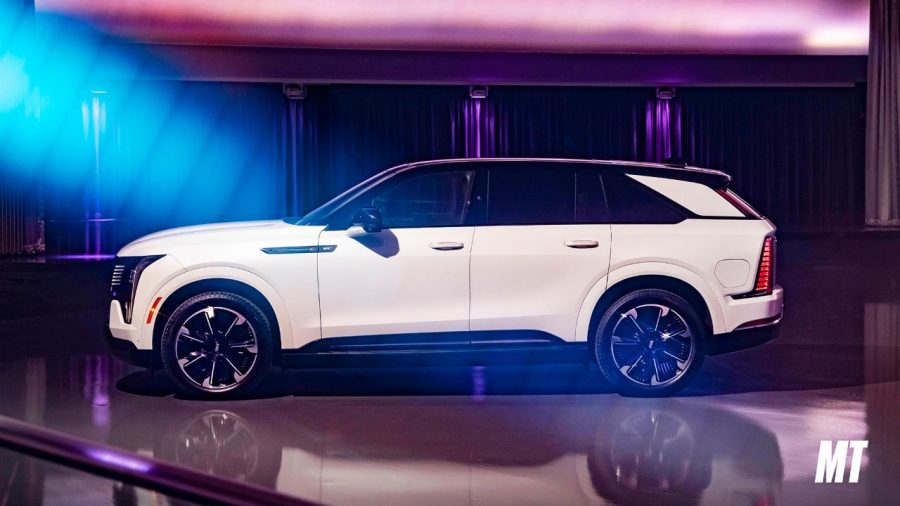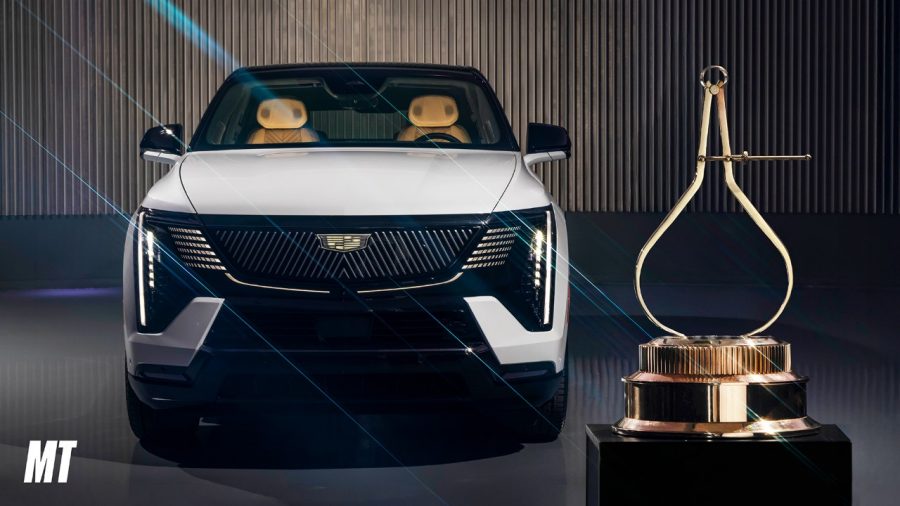By Chris Perkins, writer and editor, GM News
By Chris Perkins, writer and editor, GM News
In 1949, MotorTrend magazine held its first-ever “Car of the Year” competition, naming Cadillac the winner. It would be the first of many “of the year” victories for Cadillac and General Motors. Today, we add the ESCALADE IQ to the list, winner of MotorTrend’s 2026 SUV of the Year award. The 2026 ESCALADE IQ is the first SUV assembled in Michigan1 to win the award, but it’s not the first victory for chief engineer Al Oppenheiser.
A 40-year GM employee, Oppenheiser was chief engineer of the sixth-generation Chevrolet Camaro that won MotorTrend Car of the Year in 2016. With the ESCALADE IQ’s victory, Oppenheiser becomes the first chief engineer to win both Car of the Year and SUV of the year.
“We start out every program the same way. We sit in a room with the team and talk about what kind of awards we want to win,” Oppenheiser tells GM News. “And one of the first is always MotorTrend.”
Every year, MotorTrend judges a wide variety of vehicles based on six criteria: Efficiency, advancement in design, value, engineering excellence, performance of intended function, and safety. The sixth-generation Camaro and ESCALADE IQ are, of course, very different vehicles, but they have two qualities in common: A great architecture – the hardware and software building blocks that make up the vehicle – and excellent attention to detail.
Caption: The 2026 Cadillac Escalade IQ
“The architecture is everything,” Oppenheiser says. “With a good architecture, you’re able to take the core things you learn from the very first version and keep improving it.”
The ESCALADE IQ leverages the same architecture that underpins all of GM’s battery-electric trucks, including the Chevrolet Silverado EV, GMC Sierra EV, and GMC HUMMER EV SUT and SUV. It’s a platform Oppenheiser knows well, having been tapped in 2019 to lead development on the GMC HUMMER EV.
“To be able to do iconic vehicles like an ESCALDE IQ or a HUMMER EV, a Sierra Denali EV, Silverado RST EV, it was really kind of an architectural experiment – bringing out these electric trucks that go way over the top,” Oppenheiser says.
While the HUMMER EV was the first vehicle in this family, GM engineers continually developed the platform to accommodate the requirements of models like the ESCALDE IQ. The Cadillac benefits from technologies that debuted in the HUMMER EV. The 4-Wheel Steer that enables the CrabWalk feature on the HUMMER EV was adapted to make the ESCALDE IQ more maneuverable, for example.
It’s not just a matter of having a good platform to build on – you have to sweat the details. Oppenheiser cites the gently sloping roofline of the ESCALDE IQ, which improves aerodynamic efficiency and enables its remarkable Cadillac-estimated 465 miles of range2, or the narrow A-pillars, which aids visibility.
Caption: The 2026 Cadillac ESCALADE IQ with MotorTrend’s 2026 SUV of the Year award.
“The challenge of being responsible for a halo vehicle like an ESCALADE IQ is to earn the Cadillac and ESCALADE name,” Oppenheiser says. “To be selected as MotorTrend SUV of the Year recognizes that we went over-the-top with our delivery of our expectations. This award belongs to everyone on the ESCALADE IQ team, and it's a recognition of the thousands of hours of hard work that they put into this vehicle.”
Of course, Oppenheiser and Cadillac won’t rest on their laurels. “We've set the standard,” Oppenheiser says, “and now everyone will be shooting after us. We’ve got to keep going.” The engineering team already has the next round of advancements in sight: The 2028 ESCALDE IQ will debut eyes-off Super Cruise3, beginning with highways, as well as GM’s new centralized computing platform.
“The ESCALADE IQ is the perfect halo vehicle to introduce that new kind of technology,” Oppenheiser says. “I think it’s a credit to the vehicle, but also to the team that put it together and took it to that next level.”
1With globally sourced parts.
2On a full charge based on development testing and/or analytical projection consistent with SAE J1634 revision 2017 – MCT. Range subject to change prior to production. Actual range may vary based on several factors, including ambient temperature, terrain, battery age and condition, loading, and how you use and maintain your vehicle.
3Availability and use in accordance with local laws.

In 1949, MotorTrend magazine held its first-ever “Car of the Year” competition, naming Cadillac the winner. It would be the first of many “of the year” victories for Cadillac and General Motors. Today, we add the ESCALADE IQ to the list, winner of MotorTrend’s 2026 SUV of the Year award. The 2026 ESCALADE IQ is the first SUV assembled in Michigan1 to win the award, but it’s not the first victory for chief engineer Al Oppenheiser.
A 40-year GM employee, Oppenheiser was chief engineer of the sixth-generation Chevrolet Camaro that won MotorTrend Car of the Year in 2016. With the ESCALADE IQ’s victory, Oppenheiser becomes the first chief engineer to win both Car of the Year and SUV of the Year.
“We start out every program the same way. We sit in a room with the team and talk about what kind of awards we want to win,” Oppenheiser tells GM News. “And one of the first is always MotorTrend.”
Every year, MotorTrend judges a wide variety of vehicles based on six criteria: Efficiency, advancement in design, value, engineering excellence, performance of intended function, and safety. The sixth-generation Camaro and ESCALADE IQ are, of course, very different vehicles, but they have two qualities in common: A great architecture – the hardware and software building blocks that make up the vehicle – and excellent attention to detail.

“The architecture is everything,” Oppenheiser says. “With a good architecture, you’re able to take the core things you learn from the very first version and keep improving it.”
The ESCALADE IQ leverages the same architecture that underpins all of GM’s battery-electric trucks, including the Chevrolet Silverado EV, GMC Sierra EV, and GMC HUMMER EV SUT and SUV. It’s a platform Oppenheiser knows well, having been tapped in 2019 to lead development on the GMC HUMMER EV.
“To be able to do iconic vehicles like an ESCALADE IQ or a HUMMER EV, a Sierra Denali EV, Silverado RST EV, it was really kind of an architectural experiment – bringing out these electric trucks that go way over the top,” Oppenheiser says.
While the HUMMER EV was the first vehicle in this family, GM engineers continually developed the platform to accommodate the requirements of models like the ESCALADE IQ. The Cadillac benefits from technologies that debuted in the HUMMER EV. The 4-Wheel Steer that enables the CrabWalk feature on the HUMMER EV was adapted to make the ESCALADE IQ more maneuverable, for example.
It’s not just a matter of having a good platform to build on – you have to sweat the details. Oppenheiser cites the gently sloping roofline of the ESCALADE IQ, which improves aerodynamic efficiency and enables its remarkable Cadillac-estimated 465 miles of range2, or the narrow A-pillars, which aids visibility.

“The challenge of being responsible for a halo vehicle like an ESCALADE IQ is to earn the Cadillac and ESCALADE name,” Oppenheiser says. “To be selected as MotorTrend SUV of the Year recognizes that we went over-the-top with our delivery of our expectations. This award belongs to everyone on the ESCALADE IQ team, and it's a recognition of the thousands of hours of hard work that they put into this vehicle.”
Of course, Oppenheiser and Cadillac won’t rest on their laurels. “We've set the standard,” Oppenheiser says, “and now everyone will be shooting after us. We’ve got to keep going.” The engineering team already has the next round of advancements in sight: The 2028 ESCALADE IQ will debut eyes-off Super Cruise3, beginning with highways, as well as GM’s new centralized computing platform.
“The ESCALADE IQ is the perfect halo vehicle to introduce that new kind of technology,” Oppenheiser says. “I think it’s a credit to the vehicle, but also to the team that put it together and took it to that next level.”
1With globally sourced parts.
2On a full charge based on development testing and/or analytical projection consistent with SAE J1634 revision 2017 – MCT. Range subject to change prior to production. Actual range may vary based on several factors, including ambient temperature, terrain, battery age and condition, loading, and how you use and maintain your vehicle.
3Availability and use in accordance with local laws.